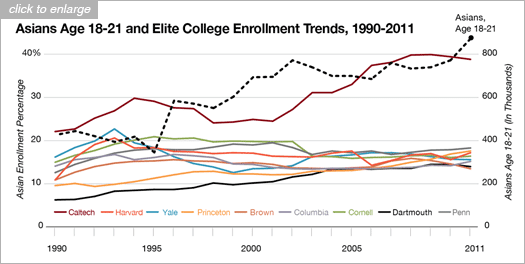In my previous entry on the topic of ideal students I ended with a question: Can you name the 2 top 25 universities that enroll nearly 40% of their incoming class who are eligible for Pell Grants? (Pell Grants are for those students whose family income is near the bottom of the income distribution in the US.) The reason I asked this question centers on the many stories in the press recently that critique elite schools for not reaching out to low-income students. Yet here are two schools that have done just that and yet there is virtually no coverage of their success. Why?
What is even more surprising, at least to me, is that the 2 schools in question, if Googled about their admission practices, will yield results that are often full of critiques and condemnations. The condemnations center on how the schools do not enroll a diverse study body. From politicians to educators to foundations people cite the failure of these schools to enroll students who come from different backgrounds.
These critiques seem at odds with the data about enrolling the most low-income students, by far, of any national university. Here is a list, from the US News, of top schools with the academic ranking and the percent of low-income students:
U.S. News rank School Percent of undergraduates receiving Pell Grants:
#23 University of California–Los Angeles Los Angeles, CA 38%
#20 University of California–Berkeley Berkeley, CA 37%
#4 Columbia University New York, NY 30%
#23 University of Southern California Los Angeles, CA 24%
#20 Emory University Atlanta, GA 23%
#2 Harvard University Cambridge, MA 20%
#7 Massachusetts Institute of Technology Cambridge, MA 20%
#16 Cornell University Ithaca, NY 18%
#5 Stanford University Stanford, CA 18%
#18 Rice University Houston, TX 17%
#5 University of Chicago Chicago, IL 17%
#7 University of Pennsylvania Philadelphia, PA 17%
#14 Brown University Providence, RI 15%
#10 Dartmouth College Hanover, NH 15%
#12 Northwestern University Evanston, IL 15%
#17 Vanderbilt University Nashville, TN 15%
#7 Duke University Durham, NC 14%
#20 Georgetown University Washington, DC 14%
#12 Johns Hopkins University Baltimore, MD 14%
#3 Yale University New Haven, CT 14%
The two schools in question, UCLA and Berkeley, have more than double the low-income students than all but 4 of the top 25 national universities. From this perspective it would seem hard to critique the schools for not enrolling a diverse group of students.
But diversity means different things to different groups and individuals. Even since the passage of Prop 209 in California, the percentage of African American and Latino students at these schools has not come close to the percentage of these groups within the State as a whole. For those who care about racial diversity the drop in the percentage of students from these groups signifies the failure of both Prop 209 and the failure of the schools to do enough to find qualified students from these groups.
It is not, however for lack of trying, that these schools have had small percentages of African American and Latino students. Many millions have been spent in outreach. Aggressive recruiting goes on from the top down at the schools themselves. Despite the commitment of the schools in terms of money and working with schools and under-represented students across California, many of these students do not qualify for admission. But even this is changing, at least for one of the groups (see below).
For the most part, the entrance of students to U Cal schools is based largely on a strict formula for academic performance. Some would call this adherence to performance a meritocracy. Others charge that it hurts certain groups of students. One group often mentioned is the low-income group. But at the 2 U Cal schools low-income students have demonstrated they can compete with those who have money.
Who are these students?
UC Berkeley Fall Enrollment Data
Ethnicity 2010 Fall 2011 Fall 2012 Fall 2010 Fall 2011 Fall 2012 Fall
African American/Black 124 130 143 3.0% 2.9% 3.4%
Mexican American/Chicano 314 326 372 7.6% 7.3% 8.9%
Other Hispanic/Latino 107 151 131 2.6% 3.4% 3.1%
Native American/Alaskan Native 28 33 29 0.7% 0.7% 0.7%
Pacific Islander 8 11 9 0.2% 0.2% 0.2%
Chinese 842 942 883 21.0% 21.2% 21.2%
Filipino 89 108 107 2.2% 2.4% 2.6%
Japanese 69 68 66 1.7% 1.5% 1.6%
Korean 201 260 224 4.9% 5.9% 5.4%
Other Asian 58 46 45 1.4% 1.0% 1.1%
South Asian 270 326 337 6.6% 7.3% 8.1%
Vietnamese 130 142 142 3.2% 3.2% 3.4%
White 1,156 1,206 1,011 28.1% 27.1% 24.3%
Decline to State 255 106 136 6.2% 2.4% 3.3%
International 436 588 527 10.6% 13.2% 12.7%
Total 4,109 4,443 4,162 100.0% 100.0% 100.0%
Underrepresented Minority 573 640 675 13.9% 14.4% 16.2%
The student population at Berkeley is one of the most diverse anywhere. And yet there is more to the story. This summer a report was released that recommended that schools stop using the category of Asian. Given the huge differences in culture and life experience the report underscores how some groups, Hmong for example who typically are at the very lowest end of the income ladder, suffer because they have been grouped in with all other Asians. For those who do not know, Asians are typically help to higher standards in admission to selective schools. I have written about this before, but in terms of standardized testing for example, Asians typically have to score over 100 points higher than any other group and in some cases the gap between students admitted who belong to different racial categories is over 300 points. Berkeley is therefore to be applauded for following the recommendation of the report. U Cal schools are the only ones I know who have done this, and I hope their example will spur others on to do the same. On the other hand, Berkeley has a better reason than most for implementing this classification system. Both Berkeley and UCLA have come under fire for enrolling too many Asians. If one adds up all the different Asian subgroups this adds up to nearly 45%. This percentage would be well over 50% if international students were counted in the racial classification. It is ironic that a student attending Berkeley (or almost any other top school) directly from China or India or Bhutan does not get classified as Asian for the purposes of the statistics. As the vast majority of international students come from Asia, this methodology does not accurately represent those backgrounds of the students.
Should the diversity of student at Berkeley be applauded? Not according to some. The reason? Asians are not considered minorities.
Admission to highly selective schools means that enrollment numbers are limited. Taking more students from one group must result in fewer students from other groups. Those who make the case for greater racial diversity must also accept that it may come at the cost of economic diversity. It is not as if low income African American and Latino students are being kept out; they simply have not reached the academic standards established by the schools to be admitted.
If the decision to enroll larger numbers of African Americans and Latinos happens who will suffer most? The obvious answer is the group who comprises the majority of students.. The group that will suffer most, then, will be Asians.
I have talked on this blog about the model minority myth and how it hurts Asians in admission, jobs, and overall perceptions. But here is another question. Are Asians minorities? The answer isn’t so simple but there are at least some who do not think so:
"It is extraordinary that the vast majority of high school graduates in this state are minorities, and they're denied the opportunities to go to their state universities," said attorney Shanta Driver for the group By Any Means Necessary.
According to some groups, Berkeley and UCLA and other U Cal schools deny minorities the opportunities to attend State universities. But a glance at the data calls this assumption into question. Less than a quarter of the students at Berkeley are white.
Should Asians count as minorities? They certainly are minorities within the population as a whole. They have certainly been discriminated against, and studies show that the discrimination against Asians in jobs and in admission is still going on today.
In addition, U Cal does not just consist of 2 schools. The system has many campuses and data about enrollment tells a story different from what many think:
Afr American 1,416
Am Indian 207
Asian Am 13,720
Hispanic/Latino 8,755
Pacific Islander 79
White/Other 8,044
Unknown 844
Total 33,065
Hispanic students now outnumber whites in terms of freshman entering the U Cal system. Too often, race in the US is couched in terms of black and white both literally and figuratively. The percentage of black students in the U Cal system is low and this has drawn great criticism. Prop 209 has been blamed, but is this the whole story? Hispanic students have gained tremendously over the past several years and Asians have dominated the overall percentages of students on campuses. Do these statistics indicate that racism in the US exists mostly toward blacks? Some would argue this is the case and there is evidence out there to back up that bias exists. On the other hand, groups which do not have the advantage thought to be given to whites have still secured places at these schools. Are there other factors at work that lead some groups to outpace whites while others underperfom compared to other groups?
The issues that surround access to elite schools are far more complex than what sound bites can cover. But one thing that needs to change is the way media covers the issue. Just this week, The Chronicle of Higher Education, the main resource for information about education for many groups and people, ran a cover story on affirmative action. Given the Supreme Court’s hearing of the Michigan case this week, it is no surprise. What is shocking, at least to me, is that the students who comprise the most successful group of students in terms of acceptance to elite schools do not merit a mention.
In setting out data to show the effects of bans on affirmative action, here is how the Chronicle portrays the issues:
“Public colleges in several states have been barred from using race in admissions. The charts below show freshman enrollment of black, Hispanic, and white students at a prominent public institution as a proportion of 18- and 19-year-olds from those groups in four of those states.”
Why would an article on race at elite state schools leave out Asians? Given that Berkeley is one of the schools highlighted in the graph (I cannot reproduce it here due to copyright), what does it mean that the most predominant group of students on campus does not merit a mention, let alone an inclusion in the conversation? The choice to exclude them is either due to simple negligence or something else.
Asians are held up as the model minority but they also undermine the simple assertion that whites rule the way thngs work in education. Rather than try to tease out the subtleties of what this data might mean it is easier just to make Asians invisible. The graphs are more dramatic in pitting the other races against one another. But this overlooks the way the world really is and permits people to assume things that may not be wholly accurate about race and education.
Inclusive enrollment statistics show that if there are quantifiable measures for acceptance into schools, then Asians will be far in excess of their percentage in the total population. This shows up again and again at selective schools. Asians far surpass their population percentages at any highly selective schools. This is true for secondary schools too.
Many people rate Thomas Jefferson High School in Fairfax, Virginia and Stuyvesant High in New York as two of the best in the US. TJ typically produces the highest number of national merit winners of any school in the country. To get accepted into these schools, students must take a test. Given this and what I have already written, it should come as no surprise both schools have huge Asian populations. Stuyvesant in now over 75% Asian.
All of ths brings me back to the original point of this particular entry that focuses on low-income students as well as to the larger frame of what makes an ideal student. Is an ideal student one who does the best academically? If so, then Asians students have, far more than any group, succeeded in ways others should admire and perhaps encourage students to emulate. And if not emulate then at least to study to learn what it is that helps these students to achieve so well compared to other groups. I think that most would agree that the basis for performance is not genetic. If we can rule this out, then there has to be something else.
And that something else is not, in many cases, money. The percentage of students attending Berkeley who are low income is high and the majority of students are Asian. While I do not have the racial breakdown data on aid (I have searched for data on financial aid distribution by race at U Cal, and if anyone has this data please contact me), it seems reasonable to conclude that many of the low income students who attend Berkeley are Asian. If almost fifty percent of the students are Asian, and nearly 40% of the students are Pell Grant eligible then it would seem likely that many Asian students are low income.
I base this supposition in part from an NPR story about low income students:
“Hoxby found that the majority of academically gifted low-income students come from a handful of places in the country: About 70 percent of them come from 15 large metropolitan areas. These areas often have highly regarded public high schools, such as Stuyvesant in New York City or Thomas Jefferson in the Washington, D.C., area. Low-income high-achieving students at these schools have close to 100 percent odds of attending an Ivy League school or other highly selective college, Hoxby says.”
Although this information does not ‘prove’ Asians are the low-income students at the schools, the high percentage of Asian students in the population would suggest that at least some of them are.
If I am right that a significant proportion of the low-income students who are accepted to top schools are Asian, then they have overcome what many perceive to be two factors that inhibit access to higher education—race and income. Such information is not highlighted by any media that covers education issues. In fact, it almost seems as if this information has been downplayed on purpose. But it seems to me that if one group has successfully negotiated the ways to get access to education and brighter futures then they should be the subject of study.
In my next entry I will make a modest proposal.








You have made some very interesting points that should be discussed and analyzed further in order to better understand diversity within our colleges and universities and how to achieve it.
ReplyDeletehttp://www.collegeirection.org